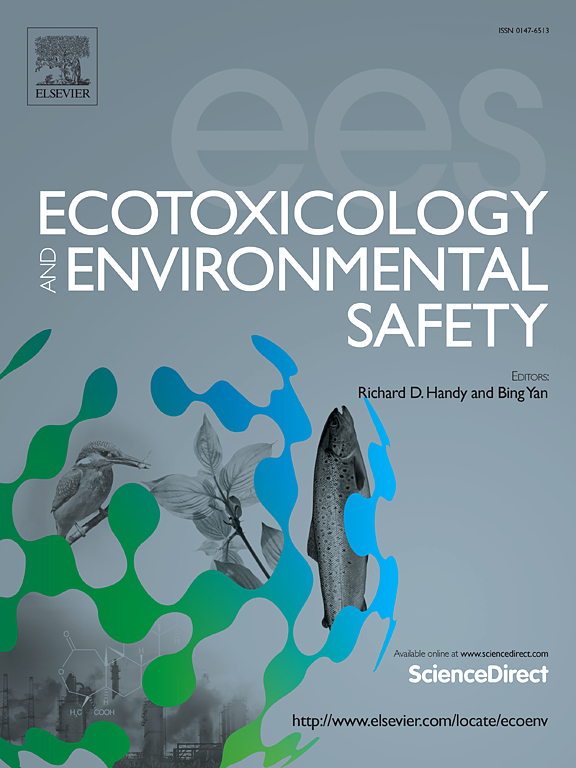Efficient removal of cadmium (II) and arsenic (III) from water by nano-zero-valent iron modified biochar-zeolite composite
IF 6.2
2区 环境科学与生态学
Q1 ENVIRONMENTAL SCIENCES
引用次数: 0
Abstract
For the removal of Cd(II) and As(III) from water, this study synthesized a nano-zero-valent iron-loaded biochar-zeolite composite material (nZVI-BCZo) using a liquid-phase reduction method, with biochar, zeolite, and FeSO₄·7H₂O as precursors. The successful incorporation of nZVI onto the BCZo was verified through Scanning Electron Microscopy (SEM), X-ray Diffraction (XRD), X-ray Photoelectron Spectroscopy (XPS), and Fourier Transform Infrared Spectroscopy (FTIR) analyses, which revealed significant modifications in the surface oxygen-containing functional groups. Batch adsorption experiments were conducted to evaluate the adsorption characteristics and performance of nZVI-BCZo for Cd(II) and As(III). Under optimal conditions (pH 6.0, temperature of 310 K, and an adsorption time of 360 min), the maximum adsorption capacities for Cd(II) and As(III) were found to be 28.09 mg/g and 186.99 mg/g, respectively. The influence of pH on removal efficiency was more pronounced than that of temperature, with nZVI-BCZo exhibiting a higher affinity for As(III) compared to Cd(II). Kinetic analysis showed that the adsorption process is primarily controlled by chemical adsorption and follows a monolayer adsorption mechanism. Regeneration tests demonstrated that nZVI-BCZo retained good adsorption capacity after three cycles, with adsorption efficiencies of 67.78 % for Cd(II) and 53.04 % for As(III), indicating its potential for repeated use in water treatment applications. The economic evaluation revealed that nZVI-BCZo has a lower processing cost. Therefore, this study established nZVI-BCZo as an efficient, reusable, and cost-effective adsorbent for the treatment of heavy metal-laden water.
纳米零价铁改性生物炭-沸石复合材料高效去除水中镉(II)和砷(III
为了去除水中的Cd(II)和As(III),本研究以生物炭、沸石和硫酸铁(FeSO₄·7H₂O)为前驱体,采用液相还原法制备了纳米级零价铁负载生物炭-沸石复合材料(nZVI-BCZo)。通过扫描电镜(SEM)、x射线衍射(XRD)、x射线光电子能谱(XPS)和傅里叶变换红外光谱(FTIR)分析,证实了nZVI在BCZo上的成功结合,发现表面含氧官能团发生了显著变化。通过批量吸附实验,考察了nZVI-BCZo对Cd(II)和As(III)的吸附特性和性能。在最佳条件(pH 6.0、温度310 K、吸附时间360 min)下,对Cd(II)和As(III)的最大吸附量分别为28.09 mg/g和186.99 mg/g。pH对As(III)去除率的影响比温度的影响更明显,nZVI-BCZo对As(III)的亲和力高于Cd(II)。动力学分析表明,吸附过程主要受化学吸附控制,并遵循单层吸附机理。再生实验表明,经过三次循环后,nZVI-BCZo仍保持良好的吸附能力,对Cd(II)的吸附效率为67.78 %,对As(III)的吸附效率为53.04 %,表明其在水处理中的重复使用潜力。经济评价表明,nZVI-BCZo具有较低的加工成本。因此,本研究确定了nZVI-BCZo是一种高效、可重复使用、经济高效的重金属水处理吸附剂。
本文章由计算机程序翻译,如有差异,请以英文原文为准。
求助全文
约1分钟内获得全文
求助全文
来源期刊
CiteScore
12.10
自引率
5.90%
发文量
1234
审稿时长
88 days
期刊介绍:
Ecotoxicology and Environmental Safety is a multi-disciplinary journal that focuses on understanding the exposure and effects of environmental contamination on organisms including human health. The scope of the journal covers three main themes. The topics within these themes, indicated below, include (but are not limited to) the following: Ecotoxicology、Environmental Chemistry、Environmental Safety etc.

 求助内容:
求助内容: 应助结果提醒方式:
应助结果提醒方式:


